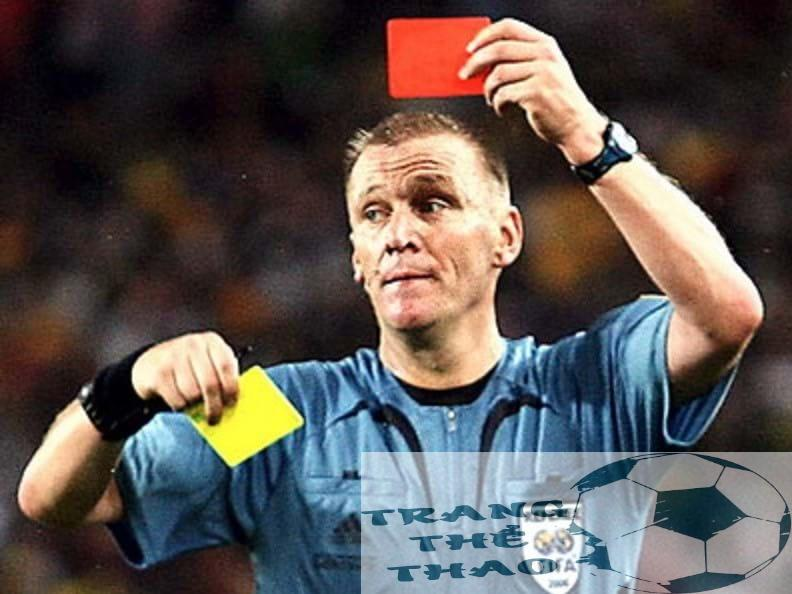N
nhuy5656
What is a red card in football (soccer)? How is being issued a red card penalized? Let's explore in detail with home win tips through the following article!

What is a red card?
What is a red card? It is a card that is typically red in color used by referees in football matches. It is used to penalize any player who commits an offense during the game. At that point, the referee has the authority to show the red card and point towards the direction of the offending player.
In the sport of football, there are various forms of penalties ranging from mild warnings to severe ones like verbal warnings, free kicks, yellow cards, and red cards. However, a red card is equivalent to receiving two yellow cards. When a player receives a red card from the referee, it signifies the most severe penalty in the match.
The act of issuing a red card by the referee serves as a distinct signal to explain, in a language understood by players, spectators, commentators, and officials alike, the severity of the offense committed. Initially, red cards were made of Bristol paper, but nowadays, they are made of plastic materials.
What are the rules of the red card in football (soccer)?
The procedure for sanctioning with a red card in football is clearly defined in Law 12 of the Laws of the Game. Specifically, any football player who receives a red card from the main referee is automatically expelled from the match and must leave the field immediately.
At this point, the team will have a player entirely sent off, and there is no right to substitute from the bench; they must continue playing with only 10 players. If there are two players sent off, the team will have to play with 9 players, and so on.
Importantly, the red card applies to all players, including starters, substitutes, and even coaches. Additionally, if the recipient of the red card is the goalkeeper, the coach can still substitute another player on the field to replace them, and of course, they can also bring in a goalkeeper from the bench.
When is it necessary to receive a red card?
Here are some cases in which a player may receive a red card that win tips bet wants to share with its readers:

Serious foul play
Whether a player's foul play is subjective or not depends on the judgment of the referee team. Actions intentionally aimed at harming players of the opposing team are considered unsportsmanlike conduct. In football, such offenses result in a red card from the referee.
Spitting and verbal abuse
Players who spit on the field will be directly shown a red card. Moreover, players who verbally abuse the opposing team or referees will also face severe penalties. These words may include insults or racial discrimination, or any other form of offensive language.
Violence
Any violent actions by players on the field, such as kicking, punching, or elbowing, will result in a red card from the referee.
Receiving two yellow cards
If a player receives two yellow cards in one match, it is equivalent to a red card. Therefore, if a player commits an offense and receives two yellow cards, they must leave the field of play.
>> See more: betting experience
What are some considerations when using a red card?
When scoring goals, players can celebrate, but excessive actions such as removing shirts or climbing fences may result in a yellow card. The decision to use a yellow or red card in situations such as a handball or committing a foul during an attack is entirely up to the referee.
In most football competitions, a player receiving several yellow cards in multiple matches may lead to the player being suspended for several subsequent matches. The general rule is that two yellow cards in a tournament can lead to a suspension. When players are sent off the field, they are not allowed to enter the team's technical area.
In most tournaments, a straight red card (meaning a player receives a red card instead of two consecutive yellow cards) results in the offending player being banned from participating in one or more subsequent matches. The team whose player receives a yellow or red card will be penalized, while the opposing team will be awarded a direct free kick.
Conclusion
The red card holds a pivotal position within the dynamics of football matches, serving as a tangible and decisive indicator of disciplinary action. It obviates the necessity for players or spectators to articulate infractions verbally, instead providing a clear and universally understood signal of serious misconduct. By offering comprehensive insights into the nature and implications of the red card, clevertips endeavors to enhance fans' comprehension of the intricate regulations governing the issuance and consequences of red cards in football.
What is a red card?
What is a red card? It is a card that is typically red in color used by referees in football matches. It is used to penalize any player who commits an offense during the game. At that point, the referee has the authority to show the red card and point towards the direction of the offending player.
In the sport of football, there are various forms of penalties ranging from mild warnings to severe ones like verbal warnings, free kicks, yellow cards, and red cards. However, a red card is equivalent to receiving two yellow cards. When a player receives a red card from the referee, it signifies the most severe penalty in the match.
The act of issuing a red card by the referee serves as a distinct signal to explain, in a language understood by players, spectators, commentators, and officials alike, the severity of the offense committed. Initially, red cards were made of Bristol paper, but nowadays, they are made of plastic materials.
What are the rules of the red card in football (soccer)?
The procedure for sanctioning with a red card in football is clearly defined in Law 12 of the Laws of the Game. Specifically, any football player who receives a red card from the main referee is automatically expelled from the match and must leave the field immediately.
At this point, the team will have a player entirely sent off, and there is no right to substitute from the bench; they must continue playing with only 10 players. If there are two players sent off, the team will have to play with 9 players, and so on.
Importantly, the red card applies to all players, including starters, substitutes, and even coaches. Additionally, if the recipient of the red card is the goalkeeper, the coach can still substitute another player on the field to replace them, and of course, they can also bring in a goalkeeper from the bench.
When is it necessary to receive a red card?
Here are some cases in which a player may receive a red card that win tips bet wants to share with its readers:
Serious foul play
Whether a player's foul play is subjective or not depends on the judgment of the referee team. Actions intentionally aimed at harming players of the opposing team are considered unsportsmanlike conduct. In football, such offenses result in a red card from the referee.
Spitting and verbal abuse
Players who spit on the field will be directly shown a red card. Moreover, players who verbally abuse the opposing team or referees will also face severe penalties. These words may include insults or racial discrimination, or any other form of offensive language.
Violence
Any violent actions by players on the field, such as kicking, punching, or elbowing, will result in a red card from the referee.
Receiving two yellow cards
If a player receives two yellow cards in one match, it is equivalent to a red card. Therefore, if a player commits an offense and receives two yellow cards, they must leave the field of play.
>> See more: betting experience
What are some considerations when using a red card?
When scoring goals, players can celebrate, but excessive actions such as removing shirts or climbing fences may result in a yellow card. The decision to use a yellow or red card in situations such as a handball or committing a foul during an attack is entirely up to the referee.
In most football competitions, a player receiving several yellow cards in multiple matches may lead to the player being suspended for several subsequent matches. The general rule is that two yellow cards in a tournament can lead to a suspension. When players are sent off the field, they are not allowed to enter the team's technical area.
In most tournaments, a straight red card (meaning a player receives a red card instead of two consecutive yellow cards) results in the offending player being banned from participating in one or more subsequent matches. The team whose player receives a yellow or red card will be penalized, while the opposing team will be awarded a direct free kick.
Conclusion
The red card holds a pivotal position within the dynamics of football matches, serving as a tangible and decisive indicator of disciplinary action. It obviates the necessity for players or spectators to articulate infractions verbally, instead providing a clear and universally understood signal of serious misconduct. By offering comprehensive insights into the nature and implications of the red card, clevertips endeavors to enhance fans' comprehension of the intricate regulations governing the issuance and consequences of red cards in football.




